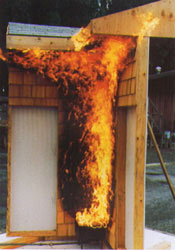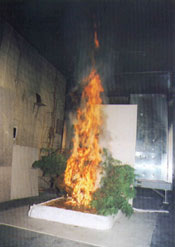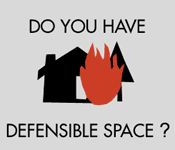 

|
This year's dry winter means that the danger of wildfires and brushfires in the hills and mountains surrounding urban areas will be unusually high. Proper selection, planting, and care of landscape plants around the home can help to reduce this danger. Here are some tips to help protect you and your home by creating a fire-wise landscape. Maintain a defensible space by clearing flammable vegetation and other materials around your house and other structures a minimum of 30 feet and up to 200 feet depending on local topography. Houses surrounded by dense vegetation need clearance of 100 feet while those on slopes and hillsides need clearance of 200 feet.
Establish and maintain a "greenbelt" of well-watered, low-growing, fire-resistant plants, like lawns and succulent groundcovers, around your home and other structures.
Consider incorporating rock, brick, concrete pathways and patios, and gravel walkways for additional protection. Mulch bare soil in the "greenbelt" with 2-3 inches of fir or redwood bark chips.
Clear and remove dead and dried plant material and debris, like leaf litter, twigs, tall grass, fallen or dead branches, and thatch build up of groundcovers and succulents to keep the landscape clear of fuel.
Thin or remove crowded woody plants to create 10-20 feet of space between shrubs and 20-40 feet between trees.
Prune branches that are near or overhang the roof. Remove lower tree branches to 10-15 feet of the ground and maintain a vegetation-free zone beneath the tree's drip line.
Well-watered trees spaced in a staggered manner away from the house can act as a barrier to intercept and prevent wind-driven burning material from reaching the home.
Many California native plants become highly flammable during drought conditions. If you landscaped with these plants, keep them well spaced to reduce their chances of carrying fire.
Water-stressed plants burn readily. Water landscape plants adequately. Deep water once a month during late summer and fall, even to drought-tolerant plants, to reduce their potential to burn. Install a sprinkler system to make watering faster, easier, and more effective.
Select fire-resistant plants. Most conifers and many species of Eucalyptus and Acacia are quite flammable. Species with shedding bark and heavy leaf litter are particularly hazardous. Plants with relatively fire-resistant foliage include deciduous trees and shrubs, plants with large, fleshy leaves, and plants lacking volatile chemicals, oils, waxes, etc.
Contact your local fire agency for specific rules and regulations and additional information about protecting lives, homes, property, and surrounding environment from wildfire. |



